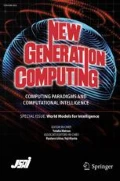Abstract
We investigated spatio-temporal pattern formation in a reaction-diffusion system assuming a periodic cellular space. The reaction space is an array of cells, where diffusion is assumed to be fast inside the cells and relatively slow in the walls separating them. The simulation results showed that the spatio-temporal development of the concentration pattern on the array depends on some specific parameters such as the diffusion coefficients in the cell walls and the size of cells. In a certain parameter region, the concentration inside each cell takes either a high or low value, and moreover, these locally discretized cells generate an alternating pattern spreading into the entire space. Whole of this process can be regarded as discretization of state, time, and space of a chemical reaction system which is intrinsically continuous. This kind of discretization mechanism is expected to provide a new way of the implementation of cellular automata based on molecular reactions.




Similar content being viewed by others
Notes
This requirement comes from the property of DNA logic gates; if all the cells have the same set of molecules, they cannot distinguish between signals from neighboring cells and their own output signal. Therefore, the molecular species used for signaling in the cells should be alternately changed. Moreover, the logic gate molecules have to be immobilized to the cell, otherwise the state of each cell cannot be properly defined.
We adopted these reaction functions so that roles of activator (u) and inhibitor (v) would be easily understood in this simple form. Since an arbitrary chemical reaction system can be implemented using DNA reactions [10], a similar reaction system can be designed with DNA molecules.
References
Turing, A.M.: The chemical basis of morphogenesis. Phil. Trans. R. Soc. Lond. B 237, 37–72 (1952)
Kondo, S., Miura, T.: Reaction-diffusion model as a framework for understanding biological pattern formation. Science 329, 1616–1620 (2010)
Murray, J.D.: Mathematical Biology. Springer, Berlin (1989)
Tyson, J.J., Fife, P.C.: Target patterns in a realistic model of the Belousov–Zhabotinskii reaction. J. Chem. Phys. 73, 2224–2237 (1980)
Miura, T., Maini, P.K.: Periodic pattern formation in reaction-diffusion systems: an introduction for numerical simulation. Anat. Sci. Int. 79, 112–123 (2004)
Lyons, M.J., Harrison, L.G.: Stripe selection: an intrinsic property of some pattern-forming models with nonlinear dynamics. Dev. Dyn. 195, 201–215 (1992)
Ermentrout, B.: Stripes or spots? Nonlinear effects in bifurcation of reaction-diffusion equations on the square. Proc. R. Soc. Lond. A 434, 413–417 (1991)
Kashima, K., Ogawa, T., Sakurai, T.: Selective pattern formation control: spatial spectrum consensus and Turing instability approach. Automatica 56, 25–35 (2015)
Chen, Y., Dalchau, N., Srinivas, N., Phillips, A., Cardelli, L., Soloveichik, D., Seelig, G.: Programmable chemical controllers made from DNA. Nat. Nanotechnol. 8, 755–762 (2013)
Soloveichika, D., Seeliga, G., Winfree, E.: DNA as a universal substrate for chemical kinetics. Proc. Natl. Acad. Sci. USA 107, 5393–5398 (2010)
Padirac, A., Fujii, T., Estévez-Torres, A., Rondelez, Y.: Spatial waves in synthetic biochemical networks. J. Am. Chem. Soc. 135, 14586–14592 (2013)
Scalise, D., Schulman, R.: Designing modular reaction-diffusion programs for complex pattern formation. Technology 02, 55–66 (2014)
Wolfram, S.: A New Kind of Science. Wolfram Media, Champaign (2002)
Wolfram, S.: Statistical mechanics of cellular automata. Rev. Mod. Phys. 55, 601–644 (1983)
Wolfram, S.: Cellular automata as models of complexity. Nature 311, 419–424 (1984)
Rendell, P.: Turing universality of the game of life. In: Collision-Based Computing, pp. 513–539 (2002)
Cook, M.: Universality in elementary cellular automata. Complex Syst. 15, 1–40 (2004)
Scalise, D., Schulman, R.: Emulating cellular automata in chemical reaction–diffusion networks. Nat. Comput. 15, 197–214 (2015)
Mimura, M. (Ed.): Pattern Formation and its Dynamics. University of Tokyo Press, Tokyo (2006) (in Japanese)
Murata, S., Konagaya, A., Kobayashi, S., Saito, H., Hagiya, M.: Molecular robotics: a new paradigm for artifacts. New Gener. Comput. 31, 27–45 (2013)
Hagiya, M., Konagaya, A., Kobayashi, S., Saito, H., Murata, S.: Molecular robots with sensors and intelligence. Acc. Chem. Res. 47, 1681–1690 (2014)
Hagiya, M., Wang, S., Kawamata, I., Murata, S., Isokawa, T., Peper, F., Imai, K.: On DNA-based gellular automata. UCNC 2014 LNCS, vol. 8553, pp. 177–189 (2014)
Acknowledgements
This work was supported by a Grant-in-Aid for Scientific Research on Innovative Areas “Molecular Robotics” (No. 24104005) of The Ministry of Education, Culture, Sports, Science, and Technology, Japan.
Author information
Authors and Affiliations
Corresponding author
About this article
Cite this article
Takabatake, F., Kawamata, I., Sugawara, K. et al. Discretization of Chemical Reactions in a Periodic Cellular Space. New Gener. Comput. 35, 213–223 (2017). https://doi.org/10.1007/s00354-017-0009-z
Received:
Accepted:
Published:
Issue Date:
DOI: https://doi.org/10.1007/s00354-017-0009-z




